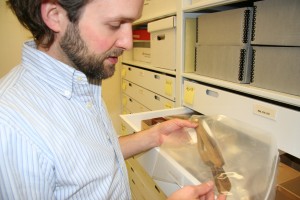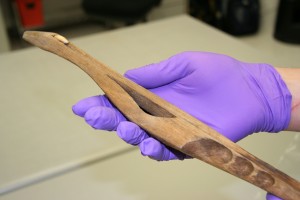Birnirk collection comes home
December 9, 2011

907-474-6941
12/9/11
A large collection of archaeological artifacts has returned to Alaska, nearly 60 years after the items were excavated near Point Barrow. The Birnirk collection represents a phase of prehistoric Eskimo culture dating back to 500 A.D.
“This collection has tremendous research significance,” said Jeff Rasic, acting curator of archaeology at the University of Alaska Museum of the North. “The Birnirk site is the ‘type site’ for the Birnirk culture, which occupies a key juncture in the branches of Eskimo prehistory and the first decidedly Eskimo phase of cultural development seen on the Alaska mainland.”
The collection was excavated in the early 1950s by a group of Harvard graduate students headed by Wilbert Carter. They completed a three-season program of archaeological work with the support of the Arctic Research Laboratory, established in Barrow by the Office of Naval Research. The collection is owned by the U.S. Navy and was housed for decades at the Harvard Peabody Museum.

Besides adding to the UA Museum of the North’s collection, which contains artifacts representing the entire span of Alaska prehistory, the donation represents a research bonanza.
“Carter never published a final report on the site,” Rasic said. “So the data and the documentation have great research potential, both in terms of bringing unpublished data to light and applying modern analytical techniques.
“There are dozens of M.A. thesis projects that could be done with this collection.”
ADDITIONAL CONTACTS: Jeff Rasic, acting archaeology curator, at Jeff_Rasic@nps.gov. Jim Whitney, archaeology collection manager, at 907-474-6943 or jwwhitney@alaska.edu.
ON THE WEB: museum.uaf.edu
TB/12-9-11/124-12


